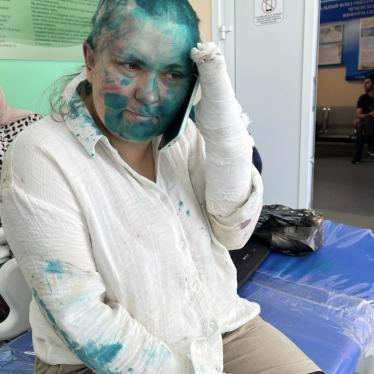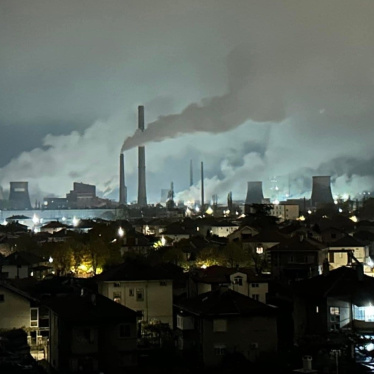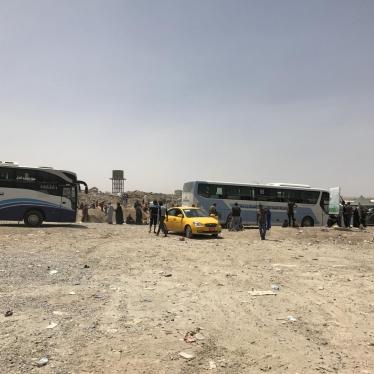Human Rights Watch charged that the Russian response to the discovery of more than fifty bodies in a village close to the main Russian military base in Chechnya has been absolutely inadequate.
As the international community gathers this week in Geneva for the U.N. Commission on Human Rights, Human Rights Watch urged the adoption of a resolution to establish an international commission of inquiry to investigate this mass grave, as well as other human rights crimes committed by Russian troops and Chechen rebel forces.
"The discovery of over fifty bodies right outside a Russian military base should have prompted an immediate and exhaustive investigation by the Russian prosecutor's office," said Holly Cartner, executive director of the Europe and Central Asia division of Human Rights Watch. "To date, that investigation has been a charade. The Russian government has focused its energy on denying any responsibility for the deaths, rather than on ensuring a meaningful investigation. As a result, a lot of important evidence has now been lost."
On February 21, 2001, relatives of three Chechen men who had "disappeared" in the custody of Russian soldiers in December 2000 discovered a large number of bodies, including those of their loved ones, in a cottage village in the immediate vicinity of the main Russian military base at Khankala. After reporting this discovery to the authorities, procuracy investigators closed off the area for civilians and started to recover the-reportedly often mined-bodies. In subsequent weeks, Russian law enforcement officials said they found another forty-eight bodies from the village.
The bodies were taken to a Ministry of Emergency Situations base and the October district police precinct in Grozny, where relatives of missing people had an opportunity to search for their loved ones. By March 13, 2001, fourteen of the forty-eight bodies had been identified and were taken away by relatives for burial. The remaining thirty-four bodies were buried in a village outside Grozny on March 10, 2001.
Immediately after news of the grave was first reported, Russian government officials denied responsibility for the bodies. They claimed the bodies were either those of Chechen rebel fighters who had been killed in battle or belonged to civilians who had been killed by Chechen rebel fighters and dumped in the village. On March 2, the Russian prosecutor overseeing the investigations in Chechnya went so far as to make the absurd suggestion that the fact that many of the dead people had worn Turkish underwear-worn by millions of people around Russia-was evidence that the dead had been rebel fighters. He also said that most of the dead men were wearing camouflage uniforms, which is not confirmed by photo and video footage of the bodies. The government failed to mention that the area in which the grave was found had been under Russian control since December 1999, long before the vast majority of the bodies were deposited there.
The government has failed utterly to conduct a credible investigation. No comprehensive forensic examinations were conducted before the bodies were reburied. As a result, important evidence has been lost. Human Rights Watch has obtained undisputable evidence that in many cases even a full description of the condition of the bodies was not made. Human Rights Watch reviewed photographs of bodies taken from the grave site that reveal that, at the time of their burial on March 10, 2001, the corpses had not been undressed nor had their arms been untied from behind their backs. Thus it is highly unlikely that forensic examiners and investigators could have examined the bodies thoroughly. During visits to the Ministry of Emergency Situations base in Grozny, researchers for Memorial Human Rights Center also learned that only a single forensic expert-who had no other equipment than rubber gloves and a scalpel-was conducting these examinations and that there was no equipment to cool the bodies for a longer period of time at the base.
Human Rights Watch also criticized the international community for failing to react appropriately to the discovery of the grave. "Instead of forcefully demanding a full investigation of the mass grave and offering to provide technical and expert assistance in doing so, the international community silently stood by while the Russian government botched the investigation," Cartner said. "This negligence is yet another example of the international community's utter failure to hold Russia to its international obligations during this conflict."
European governments and the U.S., along with most international organizations, failed even to respond publicly to the news of the grave, thus signaling to Russian officials that there would be no consequences for failing to conduct a proper investigation. The Council of Europe human rights commissioner did raise the need for a full investigation with the Russian authorities during a February 2001 trip to Russia and Chechnya, but inexplicably failed to visit the mass grave or view the sixteen bodies that had been recovered at the time. As far as Human Rights Watch is aware, no international organization or individual government offered the Russian government technical assistance or expert staff to investigate the grave.
Meanwhile, human rights organizations have been able to establish that almost all of the bodies identified were of people who had previously "disappeared" in the custody of Russian troops. On March 13, 2001, Chechen procurator V. Chernov stated that a total of seventeen bodies (including those of the first three who were recovered before the procuracy stepped in) had been identified.
As of this writing, Human Rights Watch has confirmed that twelve of the seventeen identified victims had previously "disappeared" in the custody of Russian troops. Memorial has received information identifying another four victims. All of the victims apparently had execution-style bullet wounds and at least some of the bodies bore clear signs of torture, including stab wounds, broken bones, scalped body parts, and cut off ears. These human rights organizations have also collected photo and video materials that leave no doubt that the majority of the remaining thirty-four people whose bodies were found at the Dachny village had been summarily executed, and that many had been tortured. Many had had their hands tied behind their backs and had been blindfolded, and also showed signs of multiple bullet and stab wounds.






